Source: DAOSquare
In this article we will cover:
The Origin of Meme Coin: Workload Proving the Meme Blockchain
How Meme Coins Evolve in Cycles: ICOs, Tokens, Summer of DeFi, Solana
How NFT affects the Meme currency landscape
Latest developments and new trends
Potential risks and opportunities
What is Meme?
Meme is a unit that carries cultural ideas and symbols and is constantly spreading in people’s consciousness. Like genes, memes vary in their ability to spread, with those that resonate and endure, while those with less impact are quickly forgotten.
The Internet has brought about the concept of "Internet Meme", which allows memes and cultural ideas to spread at a faster speed, often in the form of images, videos, GIFs and jokes. One study likened the spread of Internet memes to a disease: “Memes spread in a viral pattern, infecting individuals” in a SIR model reminiscent of disease spread.
Internet memes spread in a similar way to infectious diseases.
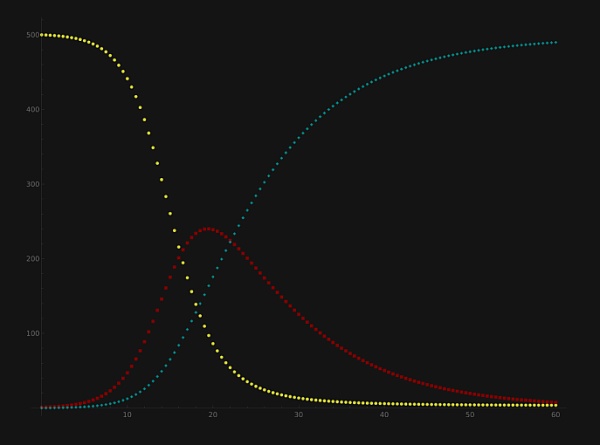
"Meme Coin" is a cryptocurrency whose value comes only from the Relevant Meme, in essence, brings financial value to the concept of Meme.
With the emergence of Meme coins, cultural ideas and symbols and their dissemination can be traded and speculated on. Their value is based on a meme’s relevancy and ability to capture mindshare, which creates a new kind of market where cultural resonance is quantifiable and has financial value.
A brief history of Meme coins
The following table and legend are a brief introduction to Crypto cycles and the Meme coins that emerged during these cycles: < /p>
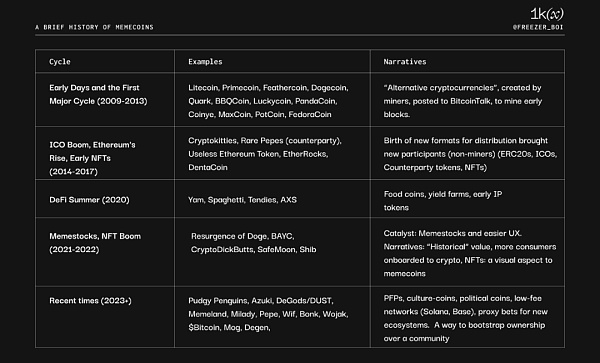

POW Meme Coin
Proof-of-Work Meme Coin is primarily designed for miners to allocate their resources to New tokens are mined and sold. Many of these meme coins debuted in the “alternative cryptocurrency” subreddit on the Bitcointalk cryptocurrency forum. While a significant number of meme coins failed to make it onto exchanges, those that did made it onto platforms like Cryptsy and BTC-E for traders to trade, these centralized services have now shut down. Each meme coin is typically distinguished by factors such as name and brand, hashing algorithm, block time, and supply, all of which together contribute to their overall narrative (or “meme”).
The first wave of tokens after Bitcoin were “meme coins”, in the sense that they offered little value other than a new idea. The image below shows some such examples:
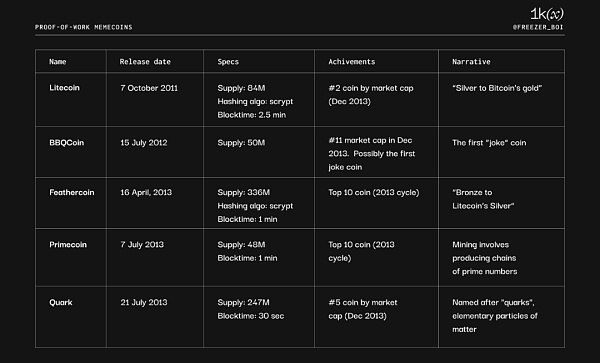
With the exception of Litecoin, all These tokens are dead (reasons include low trading volume and market capitalization, no exchange support, vulnerability to 51% attacks, etc.). This could be due to several reasons: Memes are not very sticky (lack of cultural longevity), and cost of participation issues (each Meme coin is an entire blockchain).
Litecoin’s enduring popularity may be due to the meme value (“digital gold”) of Bitcoin, which emerged much earlier than other meme coins and has also gained Ongoing support from a large number of exchanges.
Dogecoin: The First Meme Coin
Summer 2013, the original Doge meme (“There should be applause here”) Started spreading on 4chan and Reddit. On December 8, 2013, Jackson Palmer and Billy Markus capitalized on this cultural trend by launching Dogecoin on Bitcointalk. It was the first cryptocurrency based on an internet meme.
The success of Dogecoin has brought about a new "category" of cryptocurrencies that are funny, humorous, satirical, and use celebrities (e.g. Kanye West, Max Keiser), animals (e.g. Pandacoin) ) or trying to capture a specific community. These are all proof-of-work tokens launched on Bitcointalk’s “Alternative Cryptocurrency” subzone. "Technical details" become less important and everything is centered around "Meme". The image below shows some examples:
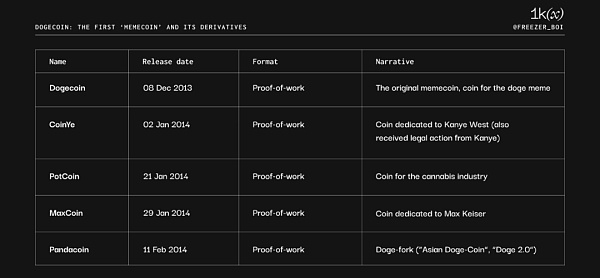
ICO craze and The Rise of Ethereum
The rise of Ethereum has triggered a wave of innovation, bringing new use cases, better user experiences, and new users.
Some specific improvements include:
Easier launch of tokens (ERC20 standard)
Brings a new user base (non-miners)
Token creators can make more money (vs. zero pre-mine PoW Tokens are different, ERC20 is sold directly through ICO)
Introducing interoperability/unified ecosystem/unified wallet (through ERC20)
p>
The ICO era has given birth to a wave of more “serious” projects, such as: theDAO, Filecoin, Tezos, EOS, Cardano, Tron and Bancor, which try to have value beyond Meme Some kind of utility or purpose. During this period, there were a handful of meme coins that, while not particularly eye-catching, still attracted some attention.
One example is the Useless Ethereum Token released in June 2017, which mocked the concept of ICO and raised 310 ETH in the ICO.
Although Dentacoin originally aimed to be the “dentist’s cryptocurrency,” it is still considered a meme coin and it reached a peak market capitalization of $2 billion in January 2018.
HAYCOIN was the first ERC20 token to be listed on Uniswap and one of the meme coins created in this era (2018). Hayden Adams, the founder of Uniswap, created the token for testing of the Uniswap protocol. It didn’t gain much attention at first and the trading volume was very small, but it was resurrected in 2023 due to its historical significance.

Collectible Meme and early NFT
Outside of cryptocurrency, a subset of Pepe the Frog memes are known as "Rare Pepes", which are memes that are not publicly released and, if released, are marked with "RARE PEPE DO NOT SAVE" watermark.
Between 2016 and 2018, a group of developers and Pepe-meme enthusiasts from Counterparty (a smart contract protocol built on Bitcoin) created the Rare Pepe wallet Pepe Cash and curated "Rare Pepe meme" to trade on the Counterparty protocol.
Rare Pepe is generally considered the second NFT series ever and continues to hold its value, with some selling for over $500,000.
With the release of CryptoPunks, MoonCats and CryptoKitties, NFTs are beginning to enter the mainstream of the Ethereum era, a non-fungible token that can point to pictures and other media. Launched as a joke on Reddit in 2017, EtherRocks is a collection of 100 multi-colored clipart rocks. The series received little response at the time (only 30 were minted), but was later resurrected and sparked a buying frenzy, reaching a floor price of 305 Ethereum in August 2021 (valued at $1 million at the time).
Another example of a collectible meme coin is Unisocks (SOCKS), launched on May 9, 2019 by Hayden Adams. He listed 500 physical socks, which can be redeemed with SOCK (ERC20). At a whopping $53,000 per pair at the time of writing, they may be the most expensive socks in the world.

DeFi Summer
In June 2020, Compound Finance pioneered a new method of token distribution: “liquidity mining” or “yield farming”. Users lock their assets to provide liquidity and are rewarded with tokens for doing so.
This new primitive kicks off the “DeFi Summer” and culminates in “food coin” yield farms that offer 10,000% annualized returns (in Meme coins) in exchange for locking your tokens in a Yam or Pickle contract.
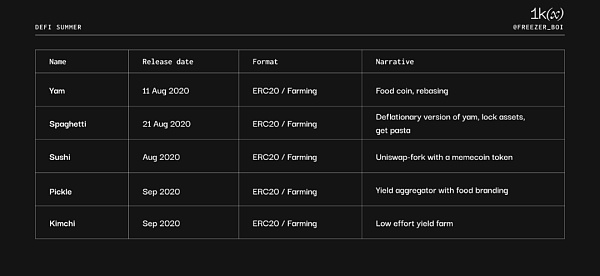
Meme Stocks and Dogecoins
Stimulus measures, interest rate cuts, cheap money, and COVID lockdowns have led to a high-risk environment globally throughout 2021.
In early 2021, retail traders gathered on Reddit and began spreading the “Gamestock” Meme, posting pictures/videos and driving rapid increases in stock prices. Thanks to Robinhood’s user-friendly experience (such as having a mobile app and no trading fees), a large number of regular users are participating.
The “GME” mania has led many people to speculate on other assets, especially those that can be traded on Robinhood. DOGE was listed on Robinhood in 2018 and was priced at 0.008 cents in late January, which was a very attractive “price” for retail users. In early February 2021, Elon Musk began tweeting heavily spreading the Doge Meme. DOGE peaked in May 2021 with a market capitalization of $90 billion.

The popularity of DOGE has spawned more canine meme coins, including Shiba Inu , Floki and Safemoon, all of which reached valuation peaks in just a few months.

NFT craze: “Meme coins with pictures”
With the introduction of the ERC721 standard and the emergence of general markets such as OpenSea, NFT has created a new "class" of crypto assets, which is a unique, "cultural ” or a unique visual expression of “Meme”.
Some of the most well-known NFTs include: CryptoPunks, Bored Apes, Squiggles, and Pudgy Penguins. NFTs can be used in profile pictures on platforms like Twitter and Discord to spread them virally by using them as markers of one’s identity. These PFPs represent a kind of prestige and “membership in a cultural club.” Many collectibles make their holders wealthy, but holders cannot sell their NFTs or otherwise "leave the community." In order to reward loyal holders, some NFT projects issue a "Meme Coin" (ERC20) to their community, thus providing the NFT with a form of value with liquidity, "utility" and cultural "currency".
Some examples of NFT projects from this era (and the Meme coins they may own) include:

Recently (2023+)
As cryptocurrencies recover from the bear market, new memes, culture, ideas and Ecology keeps emerging. Meme coins are one of the few asset classes that continues to receive traction (whether in terms of trading volume, market capitalization growth, or social interest), and interest in it has recently surged.
Some recent Meme narratives include:
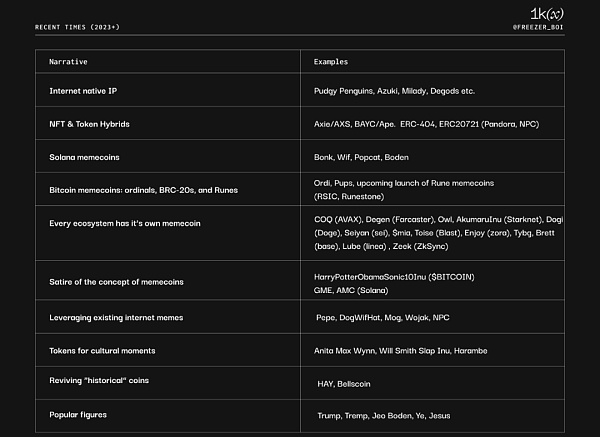
Some common models
Every cycle has some form of Meme coin: Meme coins are presented in different ways depending on the underlying technology. For example, PoW coins, ERC20 and NFT are one of the earliest "applications" of new technologies or form factors.
Although meme coins have different types of media, the way they accumulate value is the same: they all need to rely on attention, narrative, and hype to survive and spread. While new media always generate initial excitement, long-term value is maintained only through sustained attention. Just making it an NFT is not enough, just making it an Ordinal is not enough. Attention is highly cyclical. After the first wave of hype cycle of the initial media, it requires lower-level attention drivers.
Meme first, coin second: For the most successful meme coins, such as doge, pepe and dogwifhat, Internet memes came first, and the meme coins simply took advantage of the Some Meme popularity is spread and promoted.
Memes originating from Crypto have only just begun: Crypto natives have already begun to create memes that can successfully spread beyond the web3 circle. A prime example of this trend is the rise of crypto-native intellectual property, particularly NFT projects like Pudgy Penguins.
Low Price is Meme: From the earliest days of altcoins, users have loved speculating on tokens with low “prices” (due to large supply). There's a psychological allure in this, that if a seemingly insignificant token reaches $1, it could turn the holder into a millionaire overnight. Therefore, the price itself is a Meme.
Strong community + marketing: Meme coins need a strong community, founder or "spokesperson" to create content, promote the brand, and spread the "Meme".
Barbaric growth and evolution to professional operations: The first wave of Meme coins was relatively primitive, usually a fair sale, with no internal personnel or team allocations. This method of publishing has many benefits, but it also comes with some risks, such as rug-pulling, fund theft, and more. An emerging solution is for dedicated teams to promote ecological development around Meme coins, such as the PFP project.
Use strong imagery, image derivatives, and slogans to spread Meme: Imagery is the main way Meme spreads on social networks. Usually, it starts with a tone symbol and manifests itself in many different ways.
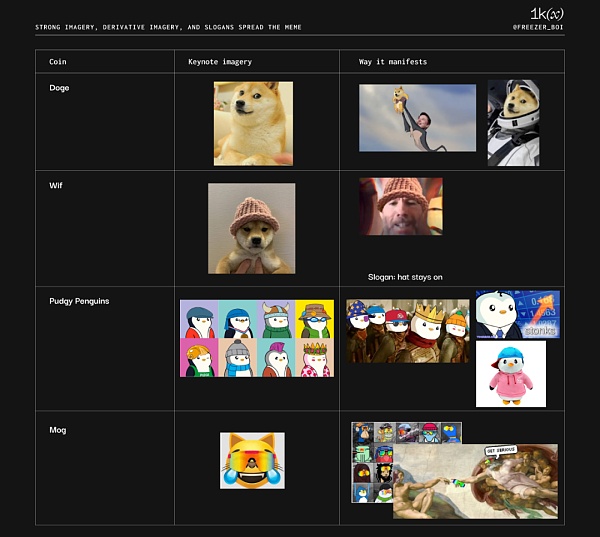
Opportunities
< p>With a total market capitalization of more than $60 billion and a daily trading volume of more than $13 billion, Meme coins hold huge financial value.
Since the only function of a Meme is to spread into other people’s minds, catching the next “Meme” early on can be a lucrative opportunity. Creators and investors “work for the meme” by amplifying its reach and are rewarded for becoming early believers in the process.
Whether it’s a lottery ticket to get rich, a choice to follow a specific KOL, or speculation on social trends and ideas, meme coins have been growing explosively since the beginning of cryptocurrencies.
Criticisms and Risks
While there are plenty of opportunities, Meme coins are not without risks. Many meme coins tend to appeal to users who are trying to gain instant wealth with little effort, viewing it as a form of lottery or gambling.
Another common trend is "pulling the carpet" and "pulling the plate to cut the leeks", which happen almost every day in the Meme currency market. Carpet pulling accounted for 99% of all Crypto scams in 2023, with total losses of $2.1 billion, according to a recent report by blockchain analytics firm CipherTrace. It is therefore particularly important to check some key characteristics of meme coins, such as the status of LP tokens (are they burned or centrally held?), team allocation, transfer taxes, and whether contract rights have been waived.
At the same time, Meme coins also lack regulatory clarity. The most high-profile meme coin regulatory incident was the Thai Securities and Exchange Commission’s ban in June 2021 on tokens that had “no clear purpose or substance” and whose prices were influenced by social media trends and KOLs.
Another major issue is that, regardless of any malicious intent, there is a chance that a Meme will not “survive” due to a lack of interest, attention, and resonance. And these investment losses can create a hostile or indifferent community of holders.
 JinseFinance
JinseFinance
 JinseFinance
JinseFinance JinseFinance
JinseFinance JinseFinance
JinseFinance JinseFinance
JinseFinance JinseFinance
JinseFinance Alex
Alex JinseFinance
JinseFinance JinseFinance
JinseFinance Samantha
Samantha Bitcoinist
Bitcoinist